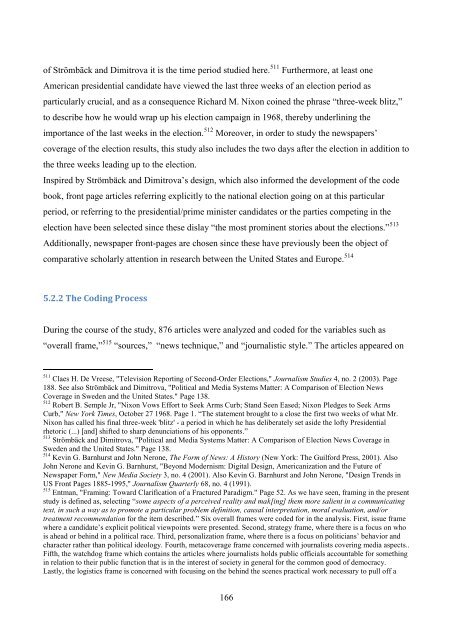The Jeremiad Over Journalism
The Jeremiad Over Journalism
The Jeremiad Over Journalism
Create successful ePaper yourself
Turn your PDF publications into a flip-book with our unique Google optimized e-Paper software.
of Strömbäck and Dimitrova it is the time period studied here. 511 Furthermore, at least one<br />
American presidential candidate have viewed the last three weeks of an election period as<br />
particularly crucial, and as a consequence Richard M. Nixon coined the phrase ―three-week blitz,‖<br />
to describe how he would wrap up his election campaign in 1968, thereby underlining the<br />
importance of the last weeks in the election. 512 Moreover, in order to study the newspapers‘<br />
coverage of the election results, this study also includes the two days after the election in addition to<br />
the three weeks leading up to the election.<br />
Inspired by Strömbäck and Dimitrova‘s design, which also informed the development of the code<br />
book, front page articles referring explicitly to the national election going on at this particular<br />
period, or referring to the presidential/prime minister candidates or the parties competing in the<br />
election have been selected since these dislay ―the most prominent stories about the elections.‖ 513<br />
Additionally, newspaper front-pages are chosen since these have previously been the object of<br />
comparative scholarly attention in research between the United States and Europe. 514<br />
5.2.2 <strong>The</strong> Coding Process<br />
During the course of the study, 876 articles were analyzed and coded for the variables such as<br />
―overall frame,‖ 515 ―sources,‖ ―news technique,‖ and ―journalistic style.‖ <strong>The</strong> articles appeared on<br />
511<br />
Claes H. De Vreese, "Television Reporting of Second-Order Elections," <strong>Journalism</strong> Studies 4, no. 2 (2003). Page<br />
188. See also Strömbäck and Dimitrova, "Political and Media Systems Matter: A Comparison of Election News<br />
Coverage in Sweden and the United States." Page 138.<br />
512<br />
Robert B. Semple Jr, "Nixon Vows Effort to Seek Arms Curb; Stand Seen Eased; Nixon Pledges to Seek Arms<br />
Curb," New York Times, October 27 1968. Page 1. ―<strong>The</strong> statement brought to a close the first two weeks of what Mr.<br />
Nixon has called his final three-week 'blitz' - a period in which he has deliberately set aside the lofty Presidential<br />
rhetoric (...) [and] shifted to sharp denunciations of his opponents.‖<br />
513<br />
Strömbäck and Dimitrova, "Political and Media Systems Matter: A Comparison of Election News Coverage in<br />
Sweden and the United States." Page 138.<br />
514<br />
Kevin G. Barnhurst and John Nerone, <strong>The</strong> Form of News: A History (New York: <strong>The</strong> Guilford Press, 2001). Also<br />
John Nerone and Kevin G. Barnhurst, "Beyond Modernism: Digital Design, Americanization and the Future of<br />
Newspaper Form," New Media Society 3, no. 4 (2001). Also Kevin G. Barnhurst and John Nerone, "Design Trends in<br />
US Front Pages 1885-1995," <strong>Journalism</strong> Quarterly 68, no. 4 (1991).<br />
515<br />
Entman, "Framing: Toward Clarification of a Fractured Paradigm." Page 52. As we have seen, framing in the present<br />
study is defined as, selecting ―some aspects of a perceived reality and mak[ing] them more salient in a communicating<br />
text, in such a way as to promote a particular problem definition, causal interpretation, moral evaluation, and/or<br />
treatment recommendation for the item described.‖ Six overall frames were coded for in the analysis. First, issue frame<br />
where a candidate‘s explicit political viewpoints were presented. Second, strategy frame, where there is a focus on who<br />
is ahead or behind in a political race. Third, personalization frame, where there is a focus on politicians‘ behavior and<br />
character rather than political ideology. Fourth, metacoverage frame concerned with journalists covering media aspects..<br />
Fifth, the watchdog frame which contains the articles where journalists holds public officials accountable for something<br />
in relation to their public function that is in the interest of society in general for the common good of democracy.<br />
Lastly, the logistics frame is concerned with focusing on the behind the scenes practical work necessary to pull off a<br />
166
















